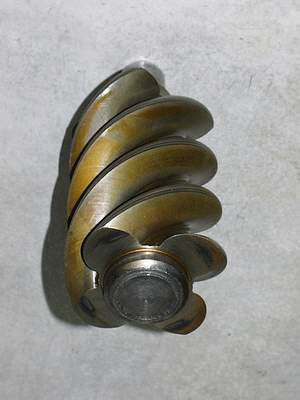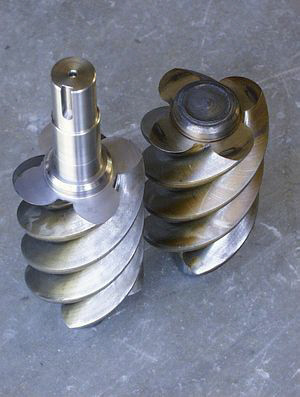
Drive Related Failures and Broken Shafts
Many
OEM airend manufacturers include disclaimers in their warranty statement for
failures due to torsional or drive problems. Our experience would indicate that
this includes a fairly large percentage of premature failures.
We
have included shaft breakage with drive related failures as a broken shaft is
usually the result of another drive problem, rather than the cause.
Perhaps the most common failure of this type that we see is shown in the photo below. In this very common scenario, the drive end bearing on the male rotor has spun on the shaft, causing a catastrophic failure. In looking at this shaft one might question the term “catastrophic”. But the real damage has occurred inside the airend as the inner race of this bearing continued to spin, cutting into the softer shaft material a mere .015” as it runs.

Because
the rotor to cylinder radial clearance on this machine is normally .0025 to .003
inches, we would find that the sealing strips would have been scrubbed off from
rubbing against the cylinder for half the length of the rotor, requiring their
replacement before reassembly.
But,
what lead up to this failure? What caused this bearing to spin while the thrust
bearings still look new? Perhaps
most directly, HEAT!
When this bearing was originally mounted
on this shaft it was very likely heated up to 250 degrees F to expand the inner
race to overcome the light .0003” to .0007” interference fit commonly used
to hold it in place. (We have also seen some manufacturers use line on line or
even slight clearance fits to speed their assembly). The combination of high
belt loads, high rotational speeds, and perhaps marginal lubrication can combine
to expand the inner race sufficiently to break its grip on the shaft. Once the
bearing begins to loosen, it is doomed to fail. Occasionally, debris in the
lubricant will become trapped in the rolling elements of a bearing, causing it
to “skid”. The friction from this skidding roller quickly heats up the inner
race with much the same result. If not caught early in the failure process, the
combination of weakened shaft and dramatically increased drag on the rotor as it
scuffs the cylinder may eventually cause the shaft to snap as seen on the next
photograph.

This
127mm belt driven rotor displays burnt spots on the inlet end of all four lobes
indicating considerable thermal growth. (There is normally quite a lot of space
between the drive end of the rotor and inlet bearing housing.) The relative lack
of debris damage to the rotor profile points to a sudden rather than protracted
failure. The consistent sealing strip height would seem to rule out a gradual
bearing failure on either end of the rotor. The dry varnish stains point to oil
starvation as a possible culprit.
Although
perhaps not the cause of this failure, the inlet bearing surface of this rotor
had apparently been welded during a previous rebuild.
We no longer weld most drive end bearing surfaces on belt driven airends, finding that installation of a replacement heat treated shaft offers much greater reliability under harsh conditions.

Are belt drives a problem? NO, but overly tight belts are. To quote a well known German manufacturer:
“Belt
tension:
Excessive tension will significantly reduce bearing life and void any warranty
coverage.”